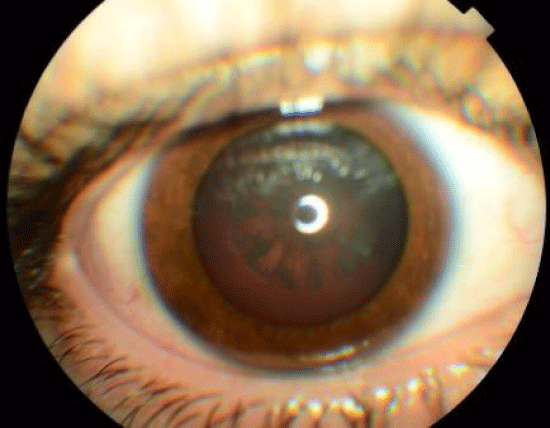Journal of Clinical Research and Ophthalmology
Congenital Unilateral Lamellar Cataract
Mohamed Abdallah Ould Hamed* and Mouzari Yassine
Cite this as
Ould Hamed MA, Yassine M (2018) Congenital Unilateral Lamellar Cataract. J Clin Res Ophthalmol 5(1): 013-013. DOI: 10.17352/2455-1414.000048Lamellar or zonular cataract is a hereditary cataract that is transmitted in an autosomal dominant mode. The crystalline opacities are located at the level of the primary fibers in the embryonic nucleus. This cataract is usually bilateral and asymmetrical. Sometimes the whole nucleus can be affected causing a significant decrease in visual acuity. We report the case of a 19-year-old patient who was consulting for a decrease in visual acuity. Ophthalmic examination revealed unilateral lamellar cataract.
Clinical Image
Lamellar or zonular cataract is a hereditary cataract that has a variable phenotype. It is transmitted in an autosomal dominant mode [1,2]. The crystalline opacities are fine and dispersed and are located at the level of the primary fibers in the embryonic nucleus [2]. This cataract is usually bilateral and asymmetrical. Sometimes the whole nucleus can be affected causing a significant decrease in visual acuity [1].
We report the case of a 19-year-old patient who was consulting for a decrease in visual acuity. The patient had no notable pathological history. His visual acuity at Snellen chart was 4/10 in the right eye and 10/10 in the left eye. The slit lamp revealed a lamellar cataract on the right eye (Figure 1). The fundus was no particularity. The patient underwent cataract surgery with an intraocular implant. The operative follow-up was uneventful and the visual acuity has improved to 10/10.
- Bu L, Jin Y, Shi Y, Chu R, Ban A, et al. (2002) Mutant DNA-binding domain of HSF4 is associated with autosomal dominant lamellar and Marner cataract. Nat Genet 31: 276-278. Link: https://goo.gl/p9KW5J
- Patil B, Sharma R, Nayak B, Sinha G, Khokhar S (2015) Pediatric cataract. Delhi J Ophthalmol 25: 160-165. Link: https://goo.gl/c1sfQd

Article Alerts
Subscribe to our articles alerts and stay tuned.
 This work is licensed under a Creative Commons Attribution 4.0 International License.
This work is licensed under a Creative Commons Attribution 4.0 International License.

 Save to Mendeley
Save to Mendeley
